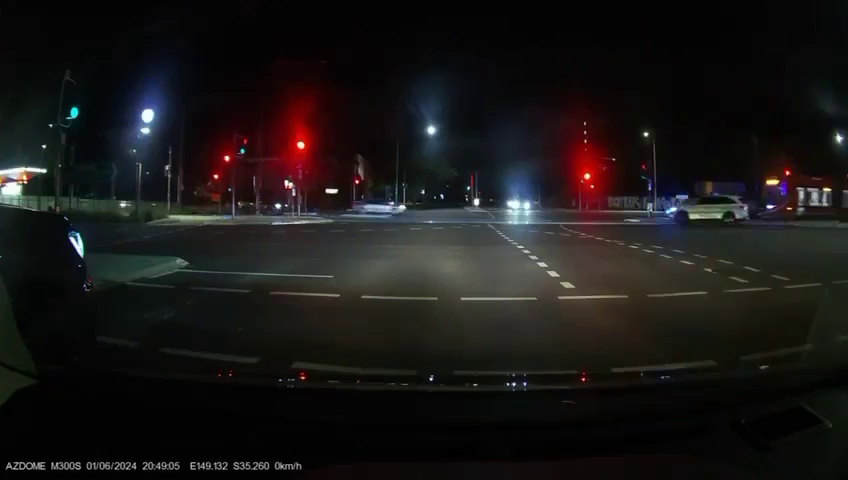
A police car collided with a light rail vehicle over the weekend. Photo: Screenshot.
Footage of a Canberra police car turning in front of a light rail vehicle on Saturday night, resulting in a collision, has prompted both shock and bemusement from the Canberra community.
Captured on Saturday when Summernats was in full swing, the video footage appears to be taken from the intersection of Northbourne and Wakefield Avenues near the light rail stop close to midnight.
A police car with flashing lights makes a right-hand turn directly in front of an oncoming light rail vehicle, colliding with the tram and spinning around in its path. The light rail vehicle, which had been moving slowly, comes to a stop immediately.
A statement from police said “About 11:50 pm on Saturday, 6 January 2024, a police vehicle was travelling north on Northbourne Avenue, when they stopped at the intersection of Northbourne Avenue and MacArthur Avenue.
“About this time, police had cause to activate their emergency lights and observed the intersection to be clear of vehicles, before proceeding against a red turn arrow.
“At this time, a light rail vehicle entered the intersection and collided with the rear of the police vehicle. No people were injured in the collision, however both the police vehicle and the light rail sustained damage as a result of the collision.
“As per ACT Policing’s standard protocols, the matter is currently being investigated”.
The film footage has been widely shared across multiple social media sites.
“Few months ago act policing posted a video of every other light rail accident, telling people to be aware of the new lights and to be careful etc …” one social media user wrote .
“I guess they’re gonna be in they’re (sic) own video compilations now?”
Another user commented: “Extra training, to be able to ignore road rules, but forgot to use their eyes …” prompting others to suggest a trip to Specsavers might be in order for the officer.
In the first three months of last year, Canberra light rail drivers reported they’d been forced to use the emergency brake 21 times, averaging once every three days.
Drivers are trained to use the emergency brake, which automatically sounds a horn, as a last resort after using a cautionary bell and regular brake.
Canberra Metro Operations general manager Bruno Lancelot said at the time the trams do not have automatic braking and rely on the driver’s “line of sight”.
“If [trams are travelling] at about 70 km/h, which is the maximum speed, [they] need around 60 metres to stop, which is double the length of a tram,” he said.
“And that’s why people need to be really, really careful when they cross in front of a tram, even if the tram is on the other side of the intersection.”
Any incidents automatically trigger an investigation by Canberra Metro Operations, with assistance from the AFP and safety regulator.
Last year, ACT Road Policing said increasing police enforcement was only part of the answer, pointing to limits on resources but noting that police were prepared to take stronger enforcement options if necessary when drivers or pedestrians flouted safety regulations regarding light rail.
Earlier this week, senior police were sharply critical of some Summernats participants despite a relatively uneventful car festival. Around 100 extra police were deployed on each day of the event both inside and outside the venue, including traffic patrol.
“If we set up an IQ-testing station at the border instead of a vehicle-testing station, we’d halve our problems,” Acting Inspector Mark Richardson said on Monday.
“The real car enthusiasts are not the problem; it’s the moron tourism”, he said, describing the trouble-makers as “a sub-species of the human race”.





















